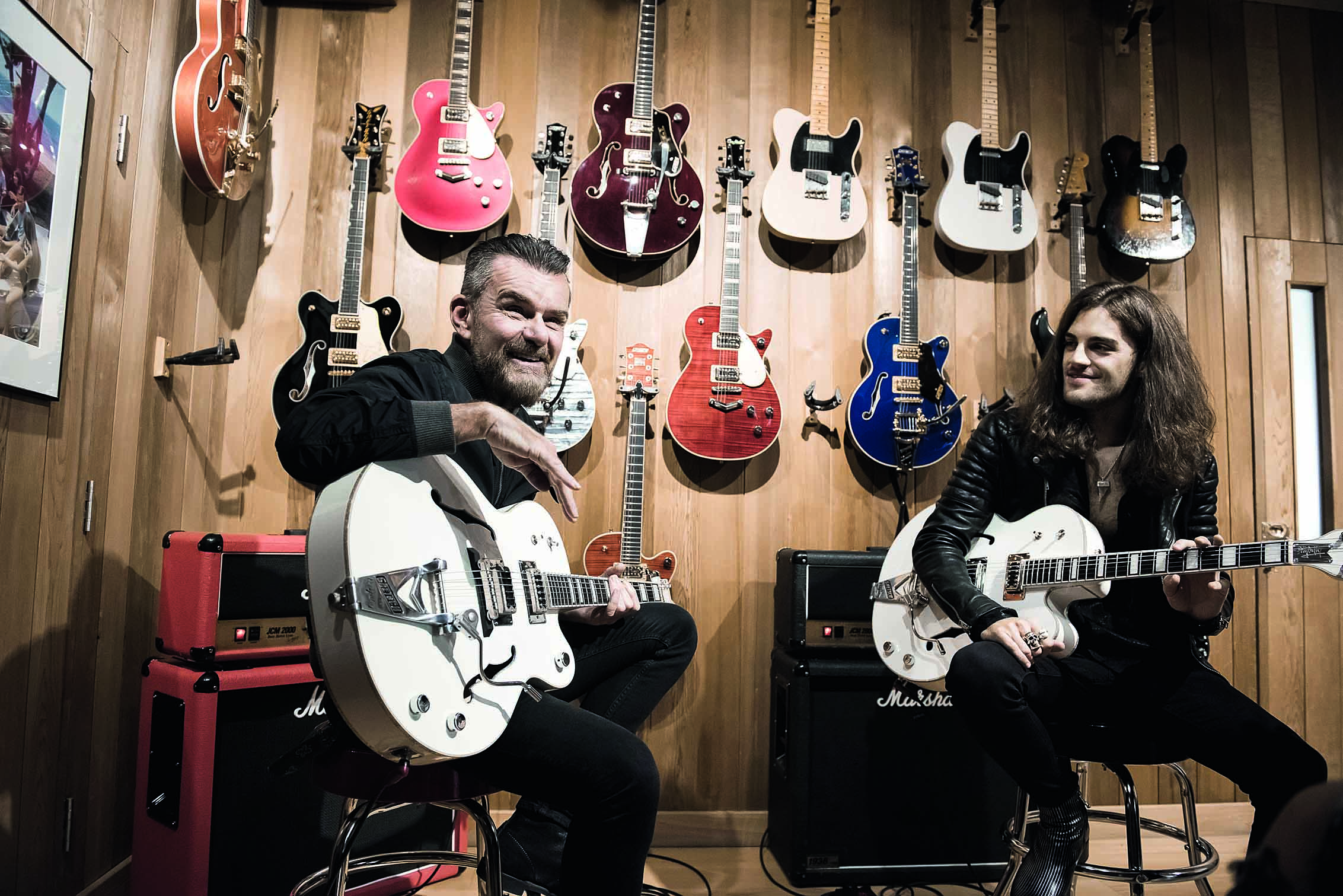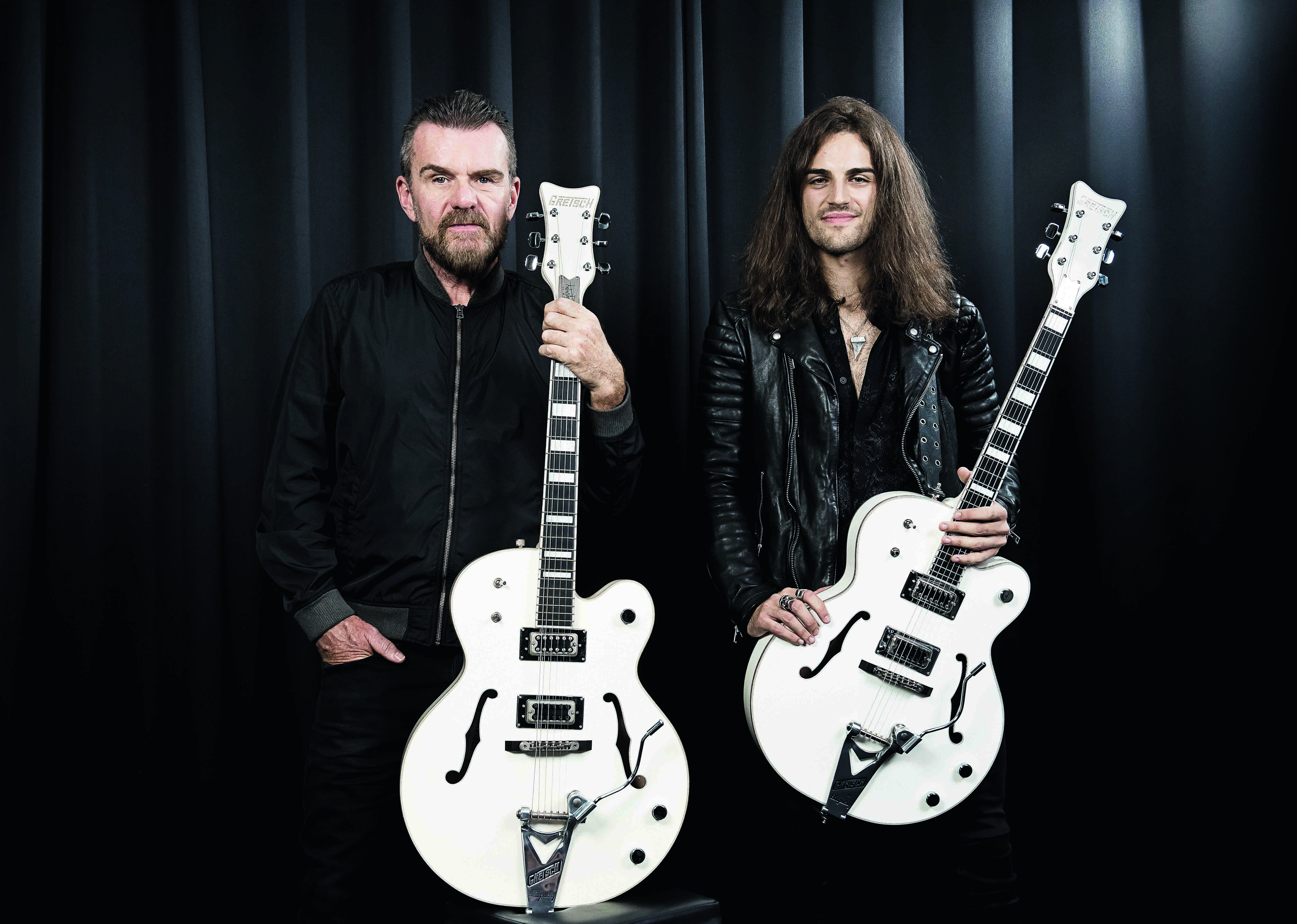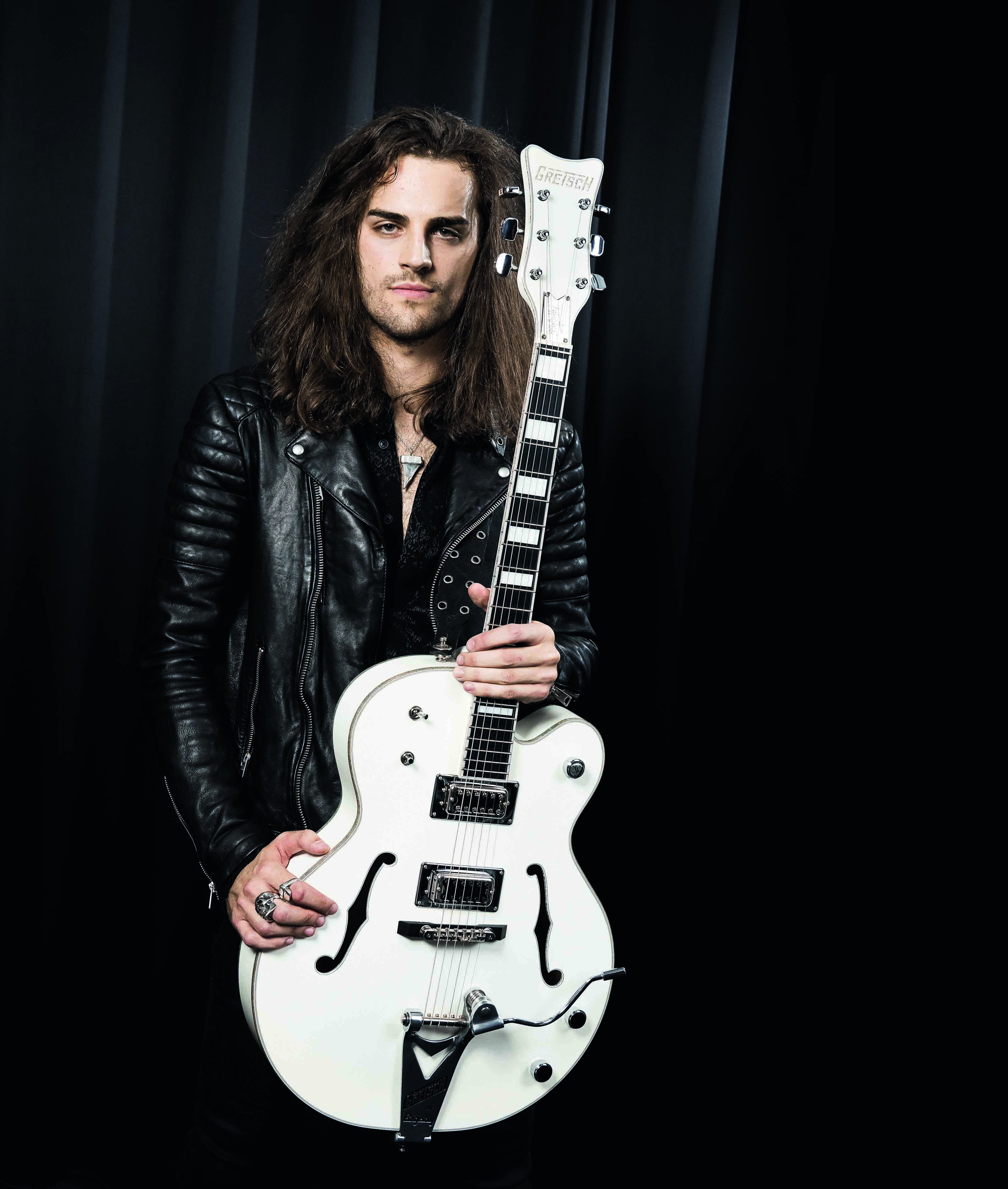The Cult's Billy Duffy: "Do you really want to go to your grave having never owned a Gretsch? It should be on the bucket list!"
The guitarist and Piston's Jack Edwards share their love for the Gretsch White Falcon
ELECTRIC GUITAR WEEK: September 24, 2006 is a certainly day that left its mark on an 11 year-old Jack Edwards. For his first gig, he was taken by his mother to see The Cult on their A Return To Wild tour at Birmingham’s Carling Academy and found himself awestruck by the sheer size and sound of Billy Duffy’s Gretsch White Falcon. After the show, the band’s roadies came over to hand out some plectrums and his fate was sealed – the young musician had found his true calling.
Twelve years and three and a half grand later, Edwards finally managed to get his hands on Duffy’s signature for use in his own band Piston, and not long after that ended up signing his own endorsement deal with Gretsch. On a late summer afternoon, the pair meet at
London rehearsal spot John Henry’s – a facility used extensively by The Cult over the years, and where some of their equipment is kept in deep storage – to discuss the art of songcraft and why they put their trust in White Falcons to do things other guitars simply can’t...
Electric Guitar Week is brought to you in association with Fender. Check out the Electric Guitar Week hub page for more tips and tutorials.
I’d never seen a guitar player before, let alone anyone playing a guitar like that
Jack Edwards
What do you remember most about that night in Birmingham?
Jack: “I’d never seen a guitar player before, let alone anyone playing a guitar like that. To my 11 year-old mind, it all felt really huge. I was brought up on records by The Cult and Guns N’ Roses, so it was very special to see Billy right in front of us.”
Billy: “That’s how it goes for every musician! We all have that gig where we breathed the same air as our heroes. Sure these days you can go on YouTube or whatever, but when you are in that room and get a glance at a musician, it can be transformational. My first gig was Slade... I’m not afraid to say it! I also saw Thin Lizzy with Eric Bell, who were on the bill along with Suzi Quatro. That was my first gig in 1972, which my dad took me to, so I must have been... 11!
Get the MusicRadar Newsletter
Want all the hottest music and gear news, reviews, deals, features and more, direct to your inbox? Sign up here.
"As for the 2006 tour, it was pretty casual. We’d gotten back together, for the second time might I add, and before I knew it, we were making an album and I wasn’t even fully aware we were doing it. I never expected it to go from then to now consistently.”
Who were the players that made you want to pick up a Gretsch in the first place, Billy?
Billy: “The first would have to be Neil Young in my pre-punk high school group, the late, great Four Way Street Band. As you can imagine by the name, there were a few Crosby, Stills, Nash and Young fans in there! I was fascinated by Gretsch guitars, they looked magical. I saw some pictures of Sylvain Sylvain from the New York Dolls... his guitar was enticing.
"The final straw was seeing Bow Wow Wow’s first-ever gig at a roller-rink in Hammersmith and Matthew Ashman, who’d been in Adam And The Ants, had one. I knew I had to get one. I liked AC/DC too, obviously Malcolm had one and I always thought the tonality of their guitars were great. Do you really want to go to your grave having never owned a Gretsch? It should be on the bucket list! Step up to the White Falcon challenge...”
Hard rock hollowbody
Did you ever get the feeling these guitars were a little less fashionable and harder to play, at least for heavy rock music?
Billy: “There are definitely a lot of pros and cons. Funnily enough, I never got along with 50s or 60s Gretsch guitars, which are the ones most people want. I always liked the 70s ones, which weren’t considered very desirable. They were made by a company called Baldwin because Gretsch were a drum manufacturer who licensed guitar designs. The Baldwin era wasn’t considered fantastic. Mostly because of the pickups, which is an easy fix.
"They stay in tune well, you have to do a few things like pin the bridge or fill it with foam. It was actually my techs who started doing that to stop them from going into therapy... especially back when I was drinking, I wanted to be so loud. I was the guy with loads of Marshall stacks and they were all on. I didn’t really get the thing about not needing all of them switched on. It was creating nuclear, seismic problems. Padding them helped, you keep a lot of the sparkle but lose the unappealing low-end feedback. Once that starts, you take off... and that’s not the sexy feedback you want.
"But actually I prefer the feel of them, built for comfort rather than speed. To get anything out of them, you really have to dig in and wrench them to get the right sound. I had a cream Les Paul custom and a Fender Twin, and I still didn’t sound as good as Steve Jones, so I gravitated. Punk was great while it lasted, but it didn’t last as long as some people thought it did. It all morphed into this big early 80s scene, post-punk made by fans who’d learn to play a bit and wanted to experiment and make music that was different... guys like The Edge or Will Sergeant.”
Jack: “After seeing Billy a few times, I’ve learned you just need to hit the thing hard! He really beats his guitars. Early on, I used to be quite shy with this guitar, but then I started giving it some welly. That’s the only way to get the full sound out of them. You have to truly play them.”
Every guitarist needs to find an overdrive they love – that’s the key.
Billy Duffy
You've both played Gibsons as well. What kind of situations tend to work better with Gretsch?
Billy: “Les Pauls bring a certain percussion that only a solid-body guitar can give you. They are very dense sonically while these don’t quite have that, although I’ve managed to get as much of it as I could. Gretsches are more fragile. I feel they have more like the atmosphere of walking into a church... wow, that’s the best analogy I’ve ever come up with in a million years of playing them.
"They have that space and reverb, it’s very church hally. And that’s what makes them so soundscapey and cinematic, like reaching for more of a Ennio Morricone tip, it was more cinematic. Especially going through two cabinets – the other guys in the band say one sounds better, but I prefer the width... and the volume! You just have to know how to control it.
"There are limits with how rock you can take it – look at AC/DC, Angus didn’t play those leads on a Gretsch. So that’s why I got into hotter pickups and trying to rein in the feedback. Ian [Astbury] calls it a grown-up’s guitar... it’s definitely not for children! To play one of these, you really have to mean it, be aggressive and control it. These guitars get wild and crazy at full-pelt in bigger rooms. There’s nothing really like it. 50% of the AC/DC sound is right there.”
Jack: “Exactly! It made such a difference when we changed from two Les Pauls to one against a Gretsch. Our sound has really opened up.”
Both of you have fairly streamlined setups, sticking to just a few basic ingredients...
Billy: “I’ve definitely become more pragmatic over time. I guess I went through the same route that most people did in the 80s, getting a massive rack of all bells and whistles. It was like an enigma code-cracking device. I’ve enjoyed going back to using regular gear, I’m not a fetishist. I use these Friedman Brown Eyes, which are like the best Marshalls you’ve ever heard, in conjunction with Chinese-made Vox AC30s.
"Originally Vox gave me the nice ones which were all hand-made. They were too clean and honest, the cheaper ones had more punch. I also used Roland JC-120s for a while – I think my original is actually sitting in deep storage here so I will have to go say hello. It’s probably the one I recorded She Sells Sanctuary with!
“Every guitarist needs to find an overdrive they love – that’s the key. Right now I use a Klon but not the two million dollar one. Mine’s a remake and I own a couple of the ones I like the best. I also like the Lovepedal Kalamazoo. Those two are similar yet dissimilar. I got rid of a lot of my modulation... I actually get the chorus put on out front! I only control delay and overdrive.”
Jack: “My rig depends on the gig – I’ll have either my Kemper or my Marshall, which I prefer. I use a Voodoo Labs Proctavia to get a beefy tone for solos. I have a Custom Audio wah which I use for a lot of the Jack White sounds, with the boost cranked over some cool delay.
"There’s a [Electro-Harmonix] Pog I use for a couple of songs, but anything more than that and things get too complicated. I get scared when I’m using more pedals, because know that it means there’s more that can go wrong. I don’t get nervous about playing but I get anxious about plugging in and getting nothing. That’s my worst fear, nothing coming out and everyone looking at me!”
Billy: “It’s happened to me all too frequently. If you can get the sounds you need without overdoing it, then less will always be better.”

Taking the lead
There’s a fair few Cult hits that utilise an open D ringing against higher notes on the G-string with a generous helping of delay. Does that ever feel like your secret weapon, Billy?
Billy: “Yeah, it has this chime and makes everything sound bigger! I saw AC/DC really early on and even when they were doing simple things, it always sounded incredible. It wasn’t about the schoolboy outfit or any of that nonsense, it was the guy on the Gretsch digging into his guitar with heavy strings and the other guy playing the same riff elsewhere on the neck. Put those two elements together and it sounded huge.
"I wanted to sound like two guitarists, so I’d use delay to make it all bigger. It was almost like ham-fisted country work, playing bottom and higher strings against each other. There was a lot of single-note and simple three-chord stuff early on, like Spiritwalker, and then I started coming up with the more famous riffs like She Sells Sanctuary with the droning D string... which I guess you could say was the money-maker!
"I’ve always been pretty loyal to Boss delays once I got out of the rack-mounted ones, I find them bomb-proof. I have mine going into the front, I’m sure technically they sound better in the loop, but I like a more raw sound. It does matter, all this stuff – we went on the road in the 80s against guys like Slash and Steve Stevens....”
And what did you learn from them?
Billy: “Steve would come out shredding. He’d use delay to trick the ear, you’d hear these little trails and I learned it was the Eddie Van Halen thing with the direct on one side and effect on the other. That’s how he got all that width. You can dial it in pretty easily and it can take your guitar from one dimension to another level entirely. On the next tour, Slash was there drinking and shredding ha ha! The one thing I learned from Slash was that no matter how much you party – and he partied a lot – you should always find time to practise.”
What kind of players influenced your approach to leads?
Billy: “When I was growing up, I always liked guitarists who wrote solos you could whistle. That was the genius part for me. I didn’t like the ones who just played for themselves, the swots who would stay at home and practice scales without living life. They’d be brilliant technically, of course, but they had no soul. Listen to guitar players who have lived a life... As a kid, I’d listen to Jimi Hendrix. I think the drugs played him with a little fear. I do admire technical excellence but it doesn’t excite me.
"I like overbending. Billy Gibbons can make one note sound more important than a thousand from anyone else. I’ve been playing with him a fair bit over the last few years, when he starts talking about touring with Hendrix in the 60s, that’s some trippy shit. It’s like going right back to the source. If you know your history – there were guitar guys like Scotty Moore and then came Hendrix, this monumental seismic shift in the whole game.”
Jack: “Through The Cult, I’ve learned to not worry about being technical because playing for the song is the most important thing. When I was younger, I didn’t think that way. I just wanted to put all my best licks into every solo. Sometimes, a song will require fast playing, but there’s no need for it a lot of the time. There needs to be insecurity and danger. My favourite solos and guitar players are the ones who almost sound like they’re second-guessing themselves. I like to be able to hear that danger; it shows we’re all human and there’s fragility in there...”

Falcon force
Can you tell us about the two White Falcons you've brought with you today?
Billy: “My signature is based on my original White Falcon that I bought in London around 1981. I wanted the double cutaway but couldn’t find one so went with a single. It has a slightly different paint job; I wanted it to look vintage without being a reproduction in any way. So there are little improvements here and there, like the Black Top Filtertron pickups, which are reverse-engineered from something Seymour Duncan made me in 1986.
"When we were making the follow-up to Love, I was trying to get a heavier sound and just couldn’t ring it out of the original pickup. It just didn’t have enough output or horsepower. In typical American fashion, Seymour told me to send him a recording of the sound I was looking for and I sent him one of a Telecaster with a humbucker. You can see the pickups on this one have oxidised after being kept in storage... they’ve relic’d! I find these guitars age differently to others. If you look at a lot of older White Falcons, the head will be a different colour to the body because of the paint. If you’re a nerd, you can trainspot your heart out with these guitars.”
I always wanted to be the guy that brought the White Falcon back into rock
Jack Edwards

Jack: "I always wanted to be the guy that brought the White Falcon back into rock. Everyone else in our scene seems to play Les Pauls or Fenders. A lot of things have been done before with those guitars, so I feel like there’s more I could achieve with a Gretsch.
"Billy had pioneered these guitars in heavier rock, but I couldn’t find one anywhere! I finally spotted one at PMT in Bristol. I called them up and had them send it to Birmingham. I was broke, but had been scraping every last penny I had together for years to finally own one. I don’t think anybody realised what I went through to buy the thing — I’d been living off beans on toast for months! I just knew that I had to have it to fulfil my dream.
"I spent my life savings on it and I remember bringing it out on the road for the first time. We literally had people turning up just to see and hear it in person — the Falcon gave me an identity that I had never had before.”
The 30th Anniversary edition of The Cult's Sonic Temple box set is out now on CD and vinyl via Beggar's Banquet. Piston's self-titled debut album is out now.
Electric Guitar Week is brought to you in association with Fender. Check out the Electric Guitar Week hub page for more tips and tutorials.
Amit has been writing for titles like Total Guitar, MusicRadar and Guitar World for over a decade and counts Richie Kotzen, Guthrie Govan and Jeff Beck among his primary influences. He's interviewed everyone from Ozzy Osbourne and Lemmy to Slash and Jimmy Page, and once even traded solos with a member of Slayer on a track released internationally. As a session guitarist, he's played alongside members of Judas Priest and Uriah Heep in London ensemble Metalworks, as well as handling lead guitars for legends like Glen Matlock (Sex Pistols, The Faces) and Stu Hamm (Steve Vai, Joe Satriani, G3).
“To be honest, I feel like I am playing a high-end Gibson guitar”: Epiphone and Guitar Center team up for a colourful riff on a cult classic with the limited edition run Les Paul Custom Widow
“The humbuckers give it so much power and such a wide variety of tones while the destruct button really sets it apart from just about any other Tele”: Fender unveils the Mike Campbell “Red Dog” Telecaster










